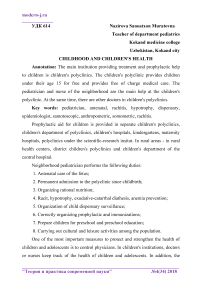Childhood and children's health
Автор: Nazirova S.M.
Журнал: Теория и практика современной науки @modern-j
Рубрика: Основной раздел
Статья в выпуске: 4 (34), 2018 года.
Бесплатный доступ
The main institution providing treatment and prophylactic help to children is children's polyclinics. The children's polyclinic provides children under their age 15 for free and provides free of charge medical care. The pediatrician and nurse of the neighborhood are the main help at the children's polyclinic. At the same time, there are other doctors in children's polyclinics.
Pediatrician, antenatal, rachitis, hypotrophy, dispensary, epidemiologist, samotoscopic, anthropometric, somometric
Короткий адрес: https://sciup.org/140273138
IDR: 140273138
Текст научной статьи Childhood and children's health
Prophylactic aid for children is provided in separate children's polyclinics, children's department of polyclinics, children's hospitals, kindergartens, maternity hospitals, polyclinics under the scientific-research insitut. In rural areas - in rural health centers, district children's polyclinics and children's department of the central hospital.
Neighborhood pediatrician performs the following duties:
-
1. Antenatal care of the fetus;
-
2. Permanent admission to the polyclinic since childbirth;
-
3. Organizing rational nutrition;
-
4. Racit, hypotrophy, exudative-catarrhal diathesis, anemia prevention;
-
5. Organization of child dispensary surveillance;
-
6. Correctly organizing prophylactic and immunizations;
-
7. Prepare children for preschool and preschool education;
-
8. Carrying out cultural and leisure activities among the population.
One of the most important measures to protect and strengthen the health of children and adolescents is to control physicians. In children's institutions, doctors or nurses keep track of the health of children and adolescents. In addition, the paramedical physician together with the pediatrician will check the implementation of the activities carried out in the area. Additionally, the epidemiologist collects and analyzes information about what measures are being taken to prevent and prevent infectious diseases and inform the appropriate site.
The main indicator of physical development and neuropathic development. At the Institute of Hygiene of Children and Adolescents, researchers share the health status of children and adolescents in five groups:
The first group includes students who are at risk of chronic or non-chronic renal failure;
The second group includes children and adolescents who suffer from chronic diseases, slightly behind morphologic, functional development, up to 4 times a year;
The third group includes children with chronic diseases or congenital diseases;
The fourth group includes children with chronic diseases, congenital heart disease, and disease;
The fifth group includes children and adolescents with severe chronic diseases and functional status.
Doctors, pedagogues, educators, parents should have a special attitude to children and adolescents, and take preventive preventive actions on time.
Observations show that 1st-grade students are more likely to have infectious diseases, especially in children under 3 years of age.
When evaluating the physical development of children and adolescents, the following samotoscopic, anthropometric, and semiotometric indicators are used. Somotoscopic indicators were determined by examining the appearance of the body. It depends on how well this person will behave when his or her body is free when standing or sitting. When the human body is normal, the waist and buttocks are slightly lowered, the shoulders are slightly lowered, and the chest is tightly attached to the ribs, slightly below the abdomen, the legs are flat and straight, the legs and legs are and will stand right.
Replacement of the spine by the front, back, back to the colon, changes in the shape of the chest wall, and the miscarriage of the legs cause the body to break down. When you are a teenager you can carry heavy loads, carry heavy books on your bookshelf regularly, and raise your chest on the side of the table and table when writing a lecture. If the feet are tied together and the touch surfaces touch each other, but there is a gap between the knee and the leg, the 'O' is called the foot shape. On the contrary, the X-shaped simon is called the leg shape if the knees touch one another and the crowns and end surfaces do not touch. Changes in the foot plaque will also result in a significant change in tachycardia. In the normal case, the deeper part of the leg is 3 to 2 parts of the compensation level. If such a foot is less than 3 to 1 or less, the foot is called "camel compensation". These people are unable to travel long distances, and they quickly become unstable, and pain is a result of the shortening of the leg muscles. The reason for this change is that young adults do not have a rickets, and do not train properly with high heeled shoes. It is also substantial in nature. However, if the cause is detected in youth, and the right measures are taken, it can be normal.
Children and adolescents suffer from chronic diseases of the nervous system, sensory organs, digestive organs, energy and metabolic disorders, respiration, blood circulation and urinary tancular organs. These diseases begin at a childhood or adolescence and if the patient does not receive treatment then it is chronic. To avoid them, it is important for the child to have proper and high-quality feeding, to maintain the routine, to keep the child healthy and to grow.
Список литературы Childhood and children's health
- Внутрипеченочный холестаз - от патогенеза к лечению / Э.П. Яковенко, П.Я. Григорьев, Н.А. Агафонова, А.В. Яковенко // Практ. врач. 1998. № 13. -С.20-23.
- Ford E.S., Giles W. H., DietsW.H.// AMA.2002.T.16, 287 (3). P 6356.
- Reaven G.M.// Diabetes, 2006


